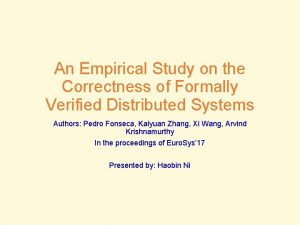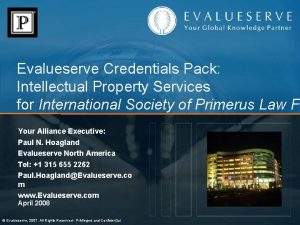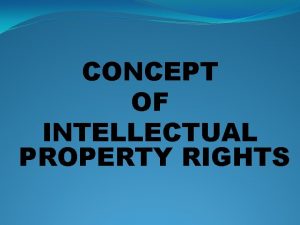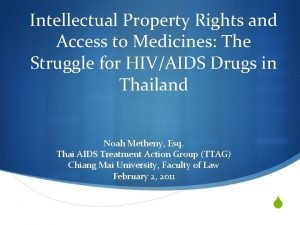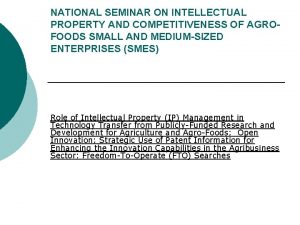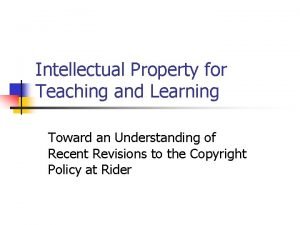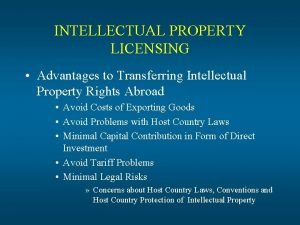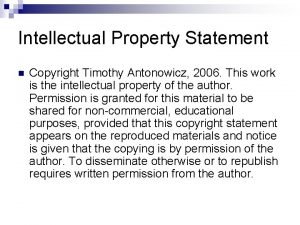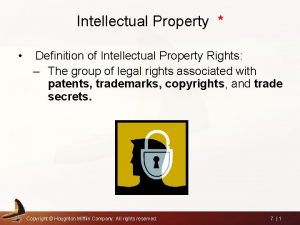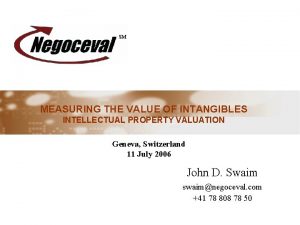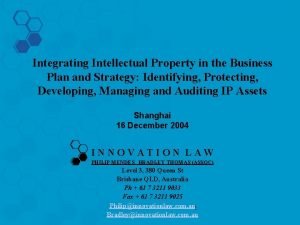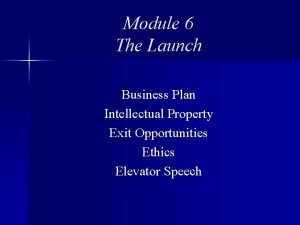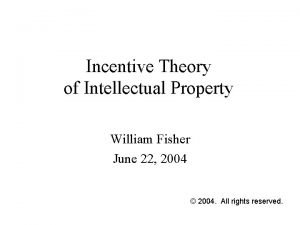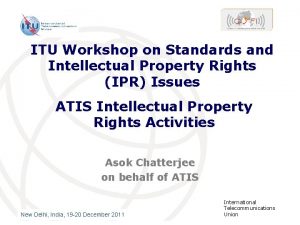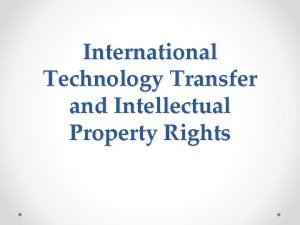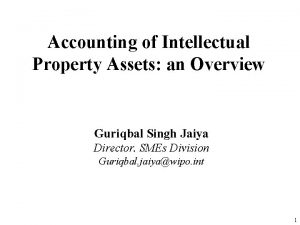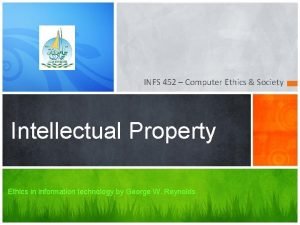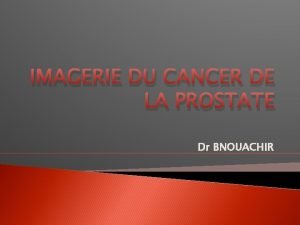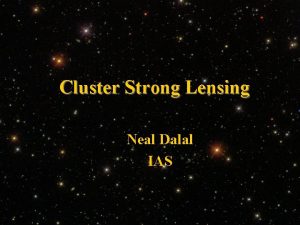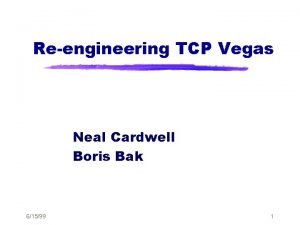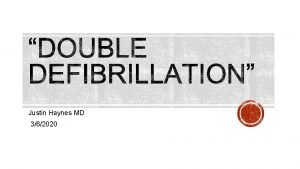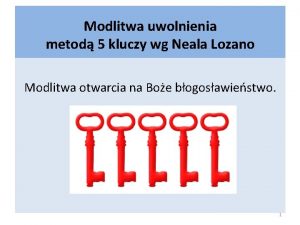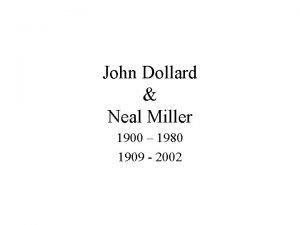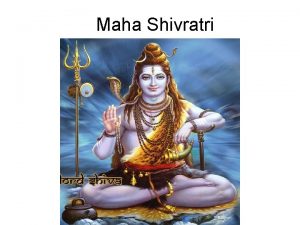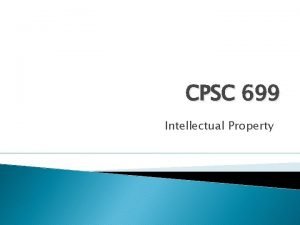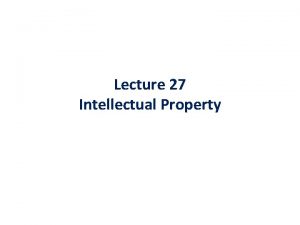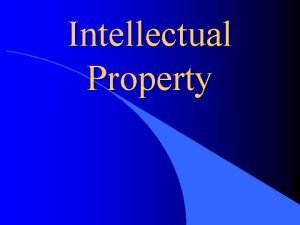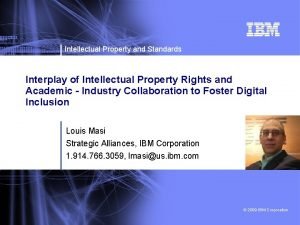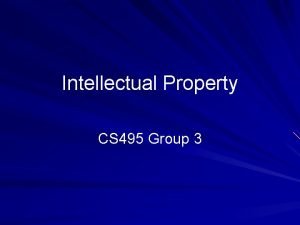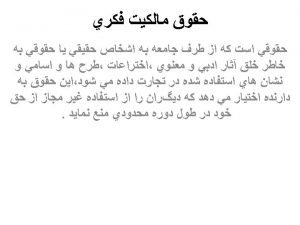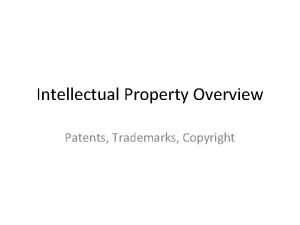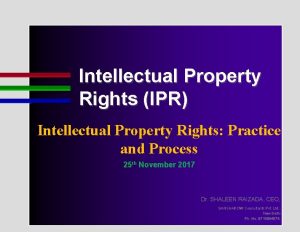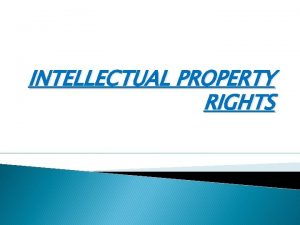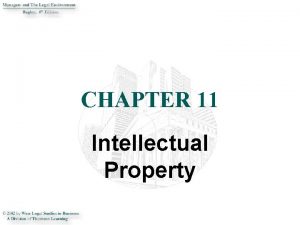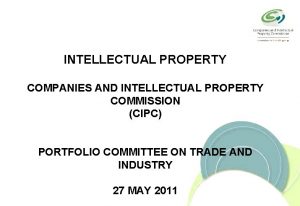Intellectual Property Amy Yancey Maha Krishnamurthy Neal Stewart






































- Slides: 38

Intellectual Property Amy Yancey, Maha Krishnamurthy, Neal Stewart

Discussion Questions • What is intellectual property, and how does it differ from tangible property? Discuss ways in which intellectual and tangible property rights can be transferred to third parties. • What is a patent, and what are the limitations on patent rights? • Contrast the “tragedy of the commons” and “tragedy of the anticommons” metaphors. • How do the metaphors relate to intellectual property, particularly in agricultural biotechnology?

Discussion Questions • What is “freedom to operate” (FTO) in the intellectual property context? What are the main issues in considering FTO when developing an improved crop variety using agricultural biotechnology? • In the E 8 case study, how does prior art preclude patenting? Discuss ways research scientist could use publications as a means to place inventions in the public domain. • While patent law has presented opportunities to protect intellectual property in the field of biotechnology, it has also generated a struggle to reconcile public and private interests. How are the emerging models represented by PIPRA and CAMBIA trying to stimulate innovation and promote open access while avoiding the tragedies of the anticommons?

What is IP • Not ideas. Ideas are not protectable, except by confidentiality • Embodiments of ideas are protectable • Intangible (intellectual property) – – Patents Copyrights Trademarks Trade Secrets • Tangible (biological materials, software)

Real Property vs. IP • Real Property: – Tangible (research materials such as vectors, genes, cell lines, etc. are usually obtained under the terms of a material transfer agreement etc. ) – Ownership is rarely limited by either geography or time • Intellectual Property: – Intangible (legal products of your mind) – IP right is geographically limited to the specific countries in which patent protection is obtained for a limited time

Forms of IP Protection

What is a patent? Provides a legal right to exclude others from: Ø Making the invention Ø Using the invention Ø Selling or offering for sale the invention Ø Importing the claimed invention A document that provides a limited monopoly Not the right to practice the invention

Types of Patents • Utility Patent – Protects a process, machine, manufacture, or composition. • Design Patent – Protects an ornamental design for an article of manufacture. • Plant Patent – Protects an invented or discovered asexually reproduced plant.

Utility Patents What kinds of things are generally patentable? v New chemical entities, including new intermediates, new salts, and enantiomers. v Methods of making new compounds. v New methods of modulating biochemical processes which are carried out in a human, animal, or plant. v New kits, for example, containing a new combination of materials or of materials and equipment used for diagnosis or treatment.

Utility Patents What kinds of things are generally patentable. . v. Newly identified DNA, so long as it is claimed in a form which differs from that in which it occurs naturally. “Myriad Supreme Court Case” disallows patenting of human genes but allows c. DNAs v. Newly created DNA is treated as a new chemical compound. v New organisms and parts of organisms such as seeds, for example, and those containing modified DNA.

Utility Patents What is not patentable? v. Laws of nature (F = ma). v. Naturally occurring things such as minerals, plants, and unaltered organisms.

Requirements A patent must: v Have utility v Does what it intends to do v Disclosed and enabled v Novel v Nonobvious: to someone of ordinary skill in the art

Loss of Foreign Patent Rights • A public disclosure of the invention without an application on file will destroy most foreign patent rights (US: 1 year gratis period) • Public disclosure = public access: – – – Published abstracts Poster presentations Online publication of manuscripts Oral paper presentations Grant submissions (if made available online, for example) – Public thesis/dissertation defense or placing it in library

Utility Patent The Owner Priority Date (ie. File Date or related application) is the "effective date of filing" for patent examination of novelty and nonobviousness. Prior art considered includes those made available to the public before the priority date.

Utility Patent Claims "comprising” open-ended term Encompasses all the elements listed, but may also include additional, unnamed elements.

Patent Due Diligence 1. Understand the patent claims providing protection of the technology platform and envisioned product 2. Patent Landscape Questions to ask? 1. Who is working in this area and are their blocking patents? 2. What part of the market does the technology IP provide protection for? 3. Can competitors design around easily? Tools for answers? 1. Resources: USPTO and Public PAIR (Patent Application Information Retrieval) to view “file wrapper” 2. IP services: law firms and search firms 3. IP Tools/Databases: private solutions such as Innography, etc. 3. Map who is working on this technology/problem to collaborate on improvements

Innovation or stagnation? IP in Ag Biotech

Patents & Public Research • Since the early 1980 s, fundamental changes in basic and applied agricultural research have complicated public research. • Historical purpose of the US LGU has changed dramatically. • The primary change was the Bayh–Dole Act, • Since that time, patenting by public research institutions and universities has increased dramatically. • While public-sector institutions contribute about 2. 7% of patents overall, their contribution to agricultural biotechnology is nearly 24% of all patents (Graff et al. 2003).

Commons & Anticommons • Patents on basic research tools (i. e. , enabling technologies, upstream v. downstream, plant transformation tools, biotechnology tools) can create patent thickets or anticommons effects and actually hinder innovation by making it economically infeasible to bring downstream technologies to market. (Heller & Eisenberg, 1998) – These can be genes, transformation tools, markers, promoters, etc. – 70 -75% of biotechnology patents are privately held = companies • The “tragedy of the commons” was coined by Garrett Hardin to explain why people overused shared resources, such as common pastures (1968).

Anticommons • Anticommons effects results from scarce resources in the hands of few that are underutilized. • In biotechnology, this relates to the proliferation , and fragmentation of IP ownership, preventing any single institution or company from assembling all of the necessary rights to produce a product or downstream technology, resulting in the underuse (or nonuse) of resources.

Anticommons Case Study: Golden Rice • Genetically enhanced rice grown in developing countries where there is a shortage of dietary vitamin A. • Over 40 patented technologies were used to develop Golden Rice for use in developing nations. • Because it’s a humanitarian crop with no commercial value, the cost of licensing all those technologies would have prohibited Golden Rice’s development had companies not been pressured to waive their fees.

Anticommons Examples • Methods for plant transformation are patented: – The ´ 061 Patent - Assignee: Monstanto -1999 Agrobacterium-mediated plant transformation method What is claimed is: 1. A method of transforming a corn plant cell or plant tissue using an Agrobacterium-mediated process comprising the steps of…. – The ´ 022 Patent - Assignee: Du. Pont - 1992 Biolistic apparatus for delivering substances into cells and tissues in a non-lethal manner • Compounded by patents on promoters, selectable markers, processes… *Photo credit: Martha Hawes, University of Arizona

First to file • Prior to the “first to file” law change in 2013, the USA was the last country using the “first to invent” standard for inventorship • Part of the America Invents Act • It doesn’t matter who invents first—the one who files for patent first is deemed the inventor

The case of the solid body electric guitar— who was the inventor? • Prior to the invention of the electric guitar, the guitar was buried in the rhythm section • Rickenbacker: “frying pan” Hawaiian slide guitar: 1931 • Gibson ES-150 was the first electric Spanish guitar: 1936 • Hollow body guitar had feedback problems, which limited amplification

Who’s who in solid body electric guitar design… Lester Polsfuss, aka, Les Paul. Early 1940 s: the “log” guitar; mid-to-late 1940 s: his “clunkers” (but the clunkers were not solid)

What about Leo Fender? • Fender Musical Instruments sold the first line of solid body electric guitars in 1950 • Esquire, then Broadcaster (Telecaster)—first prototype, May 1949 • Patent filed April 1951

But what about Paul Bigsby? • Inventor of the Bigsby tremolo “whammy bar” • Made the first playable solid body guitar “from scratch” for Merle Travis in 1948

Gibson Les Paul 1952 Bigsby’s “Merle Travis” 1948 Fender Stratocaster 1954

Freedom to Operate (FTO) • Navigating the IP landscape requires legal and scientific knowledge and searches of patent and literature databases to form a “freedom to operate” (FTO) opinion. • Determines if a project or the development of a product can proceed with a low likelihood that it will not infringe on existing IP • Opinions – – Are not absolute Reflect an evaluation of risk Uncertain interpretations about patent claims New IP may issue or be discovered later

Freedom to Operate (FTO) • Private firms are more likely to engage in FTO searches • Public and not-for-profit private institutions are becoming increasingly aware of the need – Especially in research projects undertaken by universities or not-for-profit research centers for the purpose of developing new crops

Freedom to Operate (FTO) Case Study: The E 8 Gene Promoter • A fruit-specific promoter from the tomato E 8 gene • Has been used to improve fruit quality, extend fruit shelf life, and express edible human vaccines specifically in ripening tomato fruit.

Freedom to Operate (FTO) • First, clearly define the target technology. • In this hypothetical case, the fruit specific promoter will be used exactly as described in initial publications. • The promoters in these publications are virtually identical. • Further promoter characterization identifying the location and sequence of functional elements and upstream nucleotide sequence was reported. Figure 14. 4. A family of related tomato E 8 -related patents derived from the parent application USSN 448, 095

Freedom to Operate (FTO) • The publications on the E 8 promoter provided important prior art to subsequently filed patents and showed the general application to be in the public domain with narrower specific applications covered by patents. • The search will determine important technical legal timelines that indicate whether – The technology infringes existing patents – Existing patents are valid – Claims are novel and nonobvious • If existing patents are described in prior publications are the patents invalid?

Open Access

Emerging solutions • Most plant biotechnology laboratories routinely use patented technologies in their research without permissions. • Although patent owners have rarely been concerned about academic research infringement in agriculture, this may be changing. • In many instances fundamental biomedical research has been challenged because of IP issues (Marshall 2002). Breast cancer gene. • Many researchers are unfamiliar with how to find, understand, and utilize IP information, including published patents and patent applications. • Organizations have emerged to – Address the inaccessibility of IP information – Provide a framework to ensure that IP does not block applications of agricultural biotechnology – Facilitate projects that can have broad humanitarian benefits.

Emerging solutions • Several public-sector and not-for-profit agricultural research institutions developed the Public Sector Intellectual Property Resource for Agriculture (PIPRA; www. pipra. org). • Committed to participating and promoting strategies to manage public-sector intellectual property to support US and developingcountry agriculture (Atkinson et al. 2003). • >50 institutional members in 15 countries • Among PIPRA’s core activities are: – Encouraging public institutions to make informed decisions about where and when to patent – Encouraging humanitarian exemptions in license language – Developing a clearinghouse of public IP information and analytical resources – Developing consolidated technology packages, or patent pools, particularly in the area of enabling technologies for plant transformation.

Emerging solutions • CAMBIA hopes to create a new approach to technology access in agricultural biotechnology modeled after the “open source” software movement. • The Biological Innovation for Open Society (Bi. OS) project is built on a broad philosophical foundation to “to democratize problem solving to enable diverse solutions to problems through decentralized innovation. ” • The idea is to create a “protected commons” of enabling agricultural biotechnologies that are freely available and whose use cannot be restricted by third-party patent rights. • By signing the Bi. OS license, a researcher or an institution agrees to contribute back to the pool, for free distribution, data on the use of the technology and the patent rights to any improvements made to the technology.

Other questions or discussion points?
 Neal stewart designs
Neal stewart designs Krishnamurthy viswanathan
Krishnamurthy viswanathan Sailesh krishnamurthy
Sailesh krishnamurthy Arvind krishnamurthy
Arvind krishnamurthy Evalueserve competitors
Evalueserve competitors Concept of intellectual property
Concept of intellectual property Intellectual property rights
Intellectual property rights Intellectual property management definition
Intellectual property management definition Intellectual property
Intellectual property Right to intellectual property of teachers
Right to intellectual property of teachers Trade related aspects of intellectual property rights
Trade related aspects of intellectual property rights Discuss intellectual property frankly
Discuss intellectual property frankly Characteristics of intellectual property
Characteristics of intellectual property Advantages of intellectual property
Advantages of intellectual property Intellectual property statement
Intellectual property statement Industrial property definition
Industrial property definition Intellectual property valuing
Intellectual property valuing Intellectual property in professional practices
Intellectual property in professional practices At&t ecommerce
At&t ecommerce Discuss intellectual property frankly
Discuss intellectual property frankly Intellectual property business plan example
Intellectual property business plan example Intellectual property business plan example
Intellectual property business plan example Incentive theory
Incentive theory Intellectual property rights
Intellectual property rights Importance of intellectual property
Importance of intellectual property Gaap accounting for intellectual property
Gaap accounting for intellectual property Property
Property Obstructed heritage in hindu law
Obstructed heritage in hindu law Is smell a physical property
Is smell a physical property Commutative and associative properties
Commutative and associative properties Neal creative
Neal creative Irm de prostate
Irm de prostate Angelo buono 2000
Angelo buono 2000 Ilyas neal
Ilyas neal Neal rackleff
Neal rackleff Neal cardwell
Neal cardwell Justin haynes trial
Justin haynes trial Modlitwa uwolnienia 5 kluczy pdf
Modlitwa uwolnienia 5 kluczy pdf John dollard and neal miller
John dollard and neal miller



